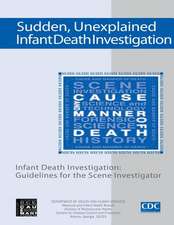Anatomy & Physiology for Health Professions: An Interactive Journey
Autor Bruce J. Colbert, Jeff Ankneyen Limba Engleză Paperback – 9 ian 2015
Preț: 334.85 lei
Preț vechi: 352.46 lei
-5% Nou
Puncte Express: 502
Preț estimativ în valută:
64.07€ • 66.74$ • 53.41£
64.07€ • 66.74$ • 53.41£
Carte disponibilă
Livrare economică 07-21 martie
Livrare express 20-26 februarie pentru 57.56 lei
Preluare comenzi: 021 569.72.76
Specificații
ISBN-13: 9780133851113
ISBN-10: 0133851117
Pagini: 576
Dimensiuni: 213 x 272 x 25 mm
Greutate: 1.02 kg
Ediția:Revised
Editura: Pearson
ISBN-10: 0133851117
Pagini: 576
Dimensiuni: 213 x 272 x 25 mm
Greutate: 1.02 kg
Ediția:Revised
Editura: Pearson
Notă biografică
Bruce Colbert is the Director of the Allied Health Department at the University of Pittsburgh at Johnstown. He holds a master's in health education and administration, has authored nine books, has written several articles, and has given over 250 invited lectures and workshops at both the regional and national levels. Many of his workshops provide teacher training involving techniques to make the health sciences engaging and relevant to today's students. In addition, he does workshops on developing effective critical and creative thinking, stress and time management, and study skills. He is an avid basketball player, even after three knee surgeries, which may indicate that he has some learning difficulties. Jeff Ankney is the Director of Clinical Education for the University of Pittsburgh at Johnstown Respiratory Care program, where he is responsible for the development and evaluation of hospital clinical sites. In the past, Jeff has served as a public school teacher, Assistant Director of Cardiopulmonary Services, Program Coordinator of Pulmonary Rehabilitation, and a member of hospital utilization review, hospital policy, strategic planning and patient safety committees. He is a consultant on hospital management and pulmonary rehabilitation concerns. Jeff was also the recipient of the American Cancer Society Public Education Award. He is a pretty fair fly fisherman and wing shot, although his springer spaniel, Rusty, would probably disagree. Karen Lee is an Associate Professor in the Biology Department at the University of Pittsburgh at Johnstown, where she teaches all the anatomy courses, including anatomy and physiology for nursing and allied health students. She presents regularly at scientific conferences and has published several articles on crustacean physiology and behavior. An active member of the Council on Undergraduate Research, she is also the chair of the University of Pittsburgh at Johnstown's annual undergraduate symposium. For the last 17 years she has sung bass in women's barbershop choruses and quartets and more recently has been harmonizing with any singer or guitar player who will let her near the microphone.
Cuprins
- Introduction to Anatomy and Physiology
- The Human Body: Reading the Map
- Biochemistry: The Basic Ingredients of Life
- The Cells: The Raw Materials and Building Blocks
- Tissues and Systems: The Inside Story
- The Skeletal System: The Framework
- The Muscular System: Movement for the Journey
- The Integumentary System: The Protective Covering
- The Nervous System (Part I): The Information Super Highway
- The Nervous System (Part II): The Traffic Control Center
- The Senses: The Sights and Sounds
- The Endocrine System: The Body's Other Control System
- The Cardiovascular System: Transport and Supply
- The Respiratory System: It's a Gas
- The Lymphatic and Immune Systems: Your Defense
- The Gastrointestinal System: Fuel for the Trip
- The Urinary System: Filtration and Fluid Balance
- The Reproductive System: Replacement and Repair
- The Journey's End: Now What?
Appendix A Answers to Test Your Knowledge Appendix B Medical Terminology, Word Parts, and Singular and Plural Endings Appendix C Clinical Abbreviations Appendix D Laboratory Reference Values Appendix E: Minerals and Vitamins: Sources, Functions, and Effects of Deficiency and Toxicity


















